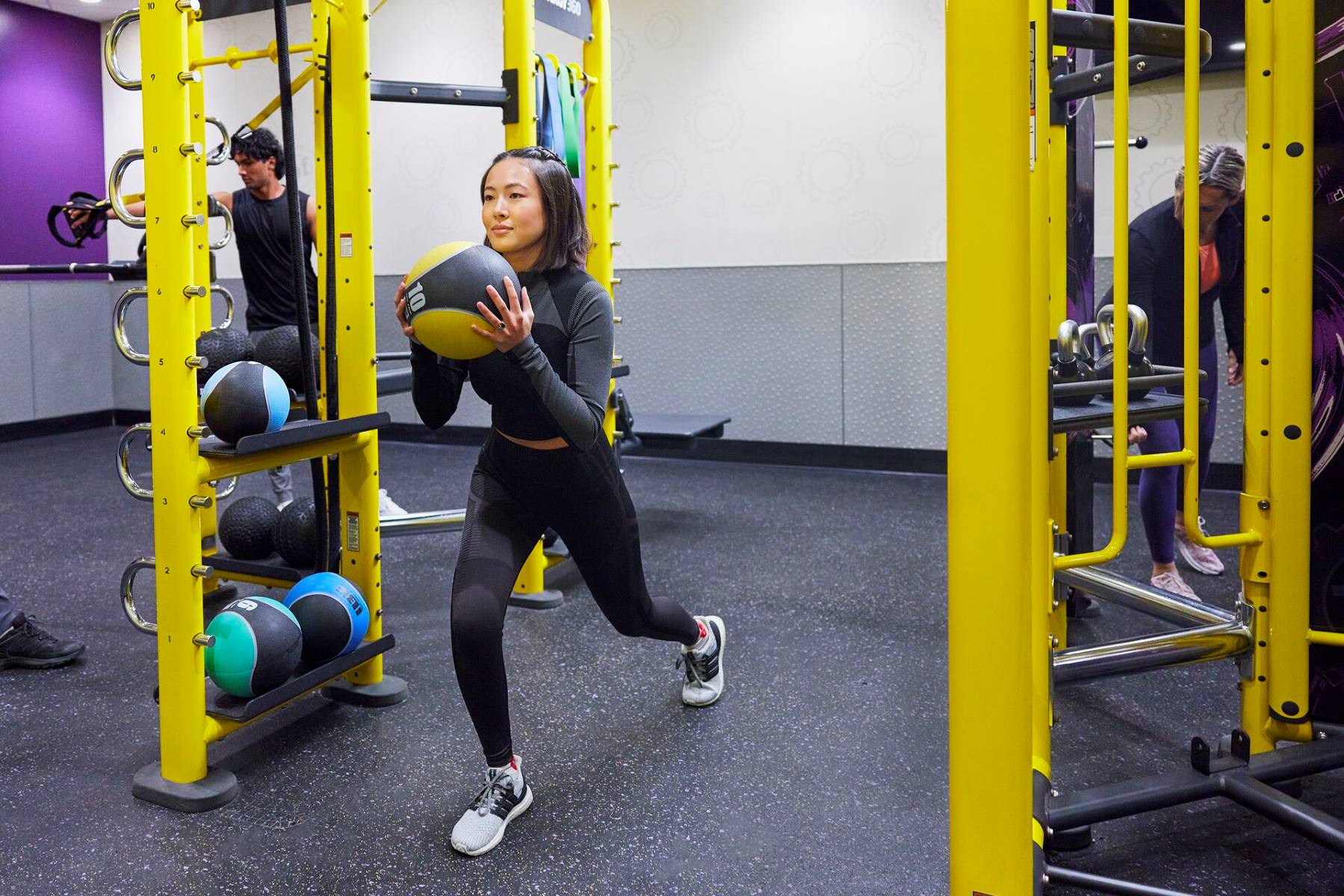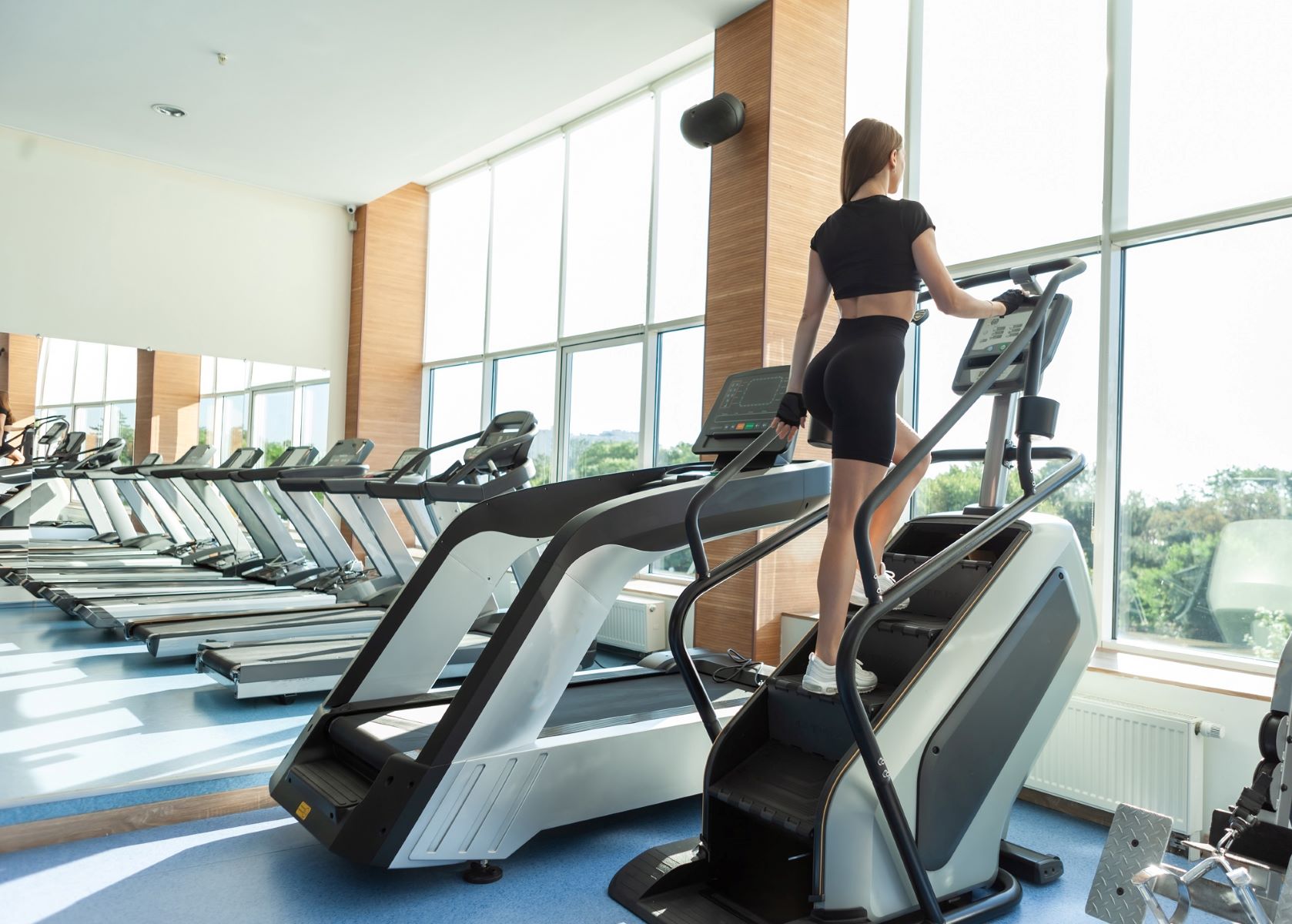Home>Misc>Featured>What Does Interval Training On A Stair Climber Look Like


Featured
What Does Interval Training On A Stair Climber Look Like
Modified: May 22, 2024
Discover how interval training on a stair climber can boost your fitness routine. Learn what featured exercises and techniques are involved to maximize your results.
Introduction:
Welcome to the world of interval training on a stair climber! If you’re looking for an effective and challenging workout that targets multiple muscle groups while getting your heart rate up, interval training on a stair climber is a great choice. This form of exercise involves alternating between periods of high-intensity effort and active recovery. Not only does it provide a cardiovascular workout, but it also helps to build strength and endurance.
Interval training is known for its efficiency in burning calories and promoting weight loss. It offers a variety of benefits that go beyond just getting in shape. It improves cardiovascular fitness, increases lung capacity, enhances metabolism, and boosts overall energy levels. Moreover, interval training is time-efficient and can be tailored to suit different fitness levels.
When it comes to choosing a stair climber, there are various options available. From traditional step machines to modern escalator-like models, you can select one that suits your preferences and fitness goals. Ensure that the machine is sturdy, adjustable, and equipped with safety features. It’s also important to wear suitable workout attire and supportive footwear to prevent injuries and maximize your comfort.
Before starting any workout, it is crucial to warm up adequately. This helps to prepare your body for the upcoming exertion and reduces the risk of injuries. Perform dynamic stretches and light cardio exercises to increase blood flow and loosen up your muscles. It’s also essential to maintain proper form throughout your workout and listen to your body’s signals to avoid overexertion.
In the next sections, we will guide you through a step-by-step interval training protocol, providing example workouts for beginners, intermediate, and advanced levels. Additionally, we will discuss the importance of cool-down exercises and how to incorporate stretching into your post-workout routine. So, let’s lace up our shoes and get ready to conquer the stair climber with interval training!
Benefits of Interval Training:
Interval training on a stair climber offers a wide range of benefits that make it a popular choice among fitness enthusiasts. Whether you’re aiming to improve cardiovascular health, increase muscle tone, or shed a few extra pounds, here are some key advantages of incorporating interval training into your fitness routine.
- Efficient Calorie Burn: Interval training is known for its ability to burn a significant number of calories in a short amount of time. By alternating between high-intensity bursts and active recovery periods, you can elevate your heart rate, boost your metabolism, and continue burning calories even after your workout is complete.
- Cardiovascular Fitness: Interval training on a stair climber is an excellent way to improve your cardiovascular health. It challenges your heart and lungs, helping to increase endurance and strengthen your cardiovascular system. Over time, this can lead to better overall heart health and increased stamina.
- Time-Efficient: Interval training allows you to get in a highly effective workout in a shorter amount of time compared to traditional steady-state cardio. By incorporating short bursts of high-intensity effort, you can achieve greater results in less time, making it a perfect fit for individuals with a busy schedule.
- Muscle Toning and Strength Building: Interval training on a stair climber engages multiple muscle groups, including your legs, glutes, core, and even your upper body when using the handrails. As you climb, you are constantly pushing and pulling against resistance, which helps to build strength and tone your muscles.
- Fat Burning: Interval training is highly effective at burning fat, particularly visceral fat that accumulates around your organs. The intense bursts of effort followed by recovery periods significantly increase your body’s calorie burn both during and after your workout, helping you shed excess body fat.
- Adaptable to Your Fitness Level: Interval training is suitable for individuals of all fitness levels. Beginners can start with shorter intervals and gradually increase the intensity and duration as their fitness improves. Likewise, advanced exercisers can challenge themselves with longer high-intensity intervals or incorporate additional resistance settings on the stair climber.
Interval training on a stair climber provides a fun and effective way to achieve your fitness goals. Whether you’re looking for weight loss, improved cardiovascular health, or increased muscle tone, incorporating interval training into your workout routine can help you attain the results you desire.
Choosing the Right Stair Climber:
When it comes to interval training on a stair climber, choosing the right machine is essential for a safe and effective workout. There are various factors to consider when selecting a stair climber that suits your needs and fitness goals. Here are some key considerations to keep in mind:
- Machine Type: There are different types of stair climbers available, including traditional step machines, revolving step machines, and escalator-like models. Traditional step machines mimic the motion of climbing stairs, while revolving step machines have a rotating platform that continually moves. Escalator-like models provide a continuously moving staircase. Consider which type of machine will provide a comfortable and enjoyable workout experience for you.
- Sturdiness and Stability: It’s important to choose a stair climber that is sturdy and stable, especially during high-intensity intervals. Look for a machine that is well-constructed and can handle your body weight without wobbling or shaking. This will ensure your safety and prevent any accidents or injuries during your workouts.
- Adjustability: The adjustability of the stair climber is crucial to accommodate your body size and fitness level. Look for a machine with adjustable step height and resistance settings. Being able to customize the intensity of your workout will allow you to challenge yourself and see progress over time.
- Safety Features: Safety should always be a top priority when using any fitness equipment. Look for a stair climber that has safety features such as handrails with a firm grip and emergency stop buttons. These features will provide stability and allow you to pause or stop the machine if needed.
- Display and Tracking Features: Many stair climbers come equipped with displays that show important workout information such as time, distance, speed, and calories burned. Look for a machine with a clear and easy-to-read display so that you can track your progress and stay motivated during your workouts.
- User-Friendly Interface: Consider the user interface of the stair climber. Look for a machine that is easy to navigate and has intuitive controls. This will make it more convenient for you to adjust settings and select different workout programs.
Before purchasing a stair climber, it’s a good idea to try out different models and see which one feels the most comfortable and suits your needs. Visit a fitness equipment store or a gym that offers stair climbers to get a hands-on experience. Remember to consider your budget as well, as the price range for stair climbers can vary.
By choosing the right stair climber, you can ensure an enjoyable and effective interval training experience. Select a machine that provides stability, adjustability, safety features, and a user-friendly interface. A well-chosen stair climber will not only enhance your workout but also keep you motivated to continue your fitness journey.
Warm-up and Safety:
Before diving into an intense interval training session on a stair climber, it’s crucial to properly warm up your body and take necessary safety precautions. A thorough warm-up prepares your muscles, joints, and cardiovascular system for the upcoming workout, while following safety guidelines ensures a safe and injury-free training session. Here are some essential warm-up and safety tips to keep in mind:
- Start with Dynamic Stretches: Begin your warm-up with dynamic stretches that involve movement. This helps to increase blood flow to your muscles and improve flexibility. Perform exercises such as leg swings, arm circles, torso twists, and ankle rotations. Focus on the major muscle groups that will be engaged during your stair climber workout, such as your quadriceps, hamstrings, calves, and glutes.
- Incorporate Light Cardiovascular Exercise: After completing your dynamic stretches, engage in light cardiovascular exercise to elevate your heart rate gradually. This could include activities like brisk walking, light jogging in place, or cycling at a moderate intensity. Aim for 5-10 minutes of cardio exercise to warm up your cardiovascular system and increase blood circulation throughout your body.
- Proper Form: Before stepping onto the stair climber, familiarize yourself with the correct form and technique. Stand tall, engage your core, and maintain a steady posture throughout the workout. Avoid leaning on the handrails for support, as this can compromise the effectiveness of the workout and strain your upper body. Instead, let your legs and glutes do the work.
- Adjust the Machine Settings: Set the stair climber to a comfortable starting level. If you’re a beginner, start with a lower step height and resistance level. As you become more experienced and comfortable, gradually increase the intensity and resistance. This will help prevent overexertion and reduce the risk of injury.
- Maintain Proper Foot Placement: Ensure that your feet are securely placed on the steps of the stair climber. Keep your weight balanced evenly on both feet and avoid excessive pressure on the toes or heels. This will help prevent slipping and keep you stable during your workout.
- Listen to Your Body: Pay attention to your body’s signals throughout the workout. If you experience any pain, discomfort, or dizziness, it’s important to stop and assess the situation. Take breaks when needed and never push yourself past your limits. It’s better to start slowly and gradually increase the intensity over time.
- Stay Hydrated: Hydration is key during any physical activity. Ensure that you are well-hydrated before, during, and after your stair climber workout. Keep a water bottle nearby and take sips of water regularly to prevent dehydration.
- Cool-down: After completing your interval training session, take the time to cool down and allow your heart rate to gradually return to its resting state. Perform light cardio exercises such as walking or stretching for 5-10 minutes. This will help prevent muscle stiffness and promote recovery.
- Stretching: Finish your workout with static stretching to improve flexibility and reduce muscle soreness. Focus on the muscles that were targeted during your stair climber workout, including your quadriceps, hamstrings, calves, and glutes. Hold each stretch for 15-30 seconds, without bouncing or forcing the movement.
By following these warm-up and safety guidelines, you’ll reduce the risk of injuries and ensure a safe and effective interval training session on the stair climber. Remember to listen to your body, maintain proper form, and gradually progress your workout intensity. With the right warm-up and safety measures in place, you can maximize your performance and achieve your fitness goals more effectively.
Interval Training Protocol:
Interval training on a stair climber follows a specific protocol that involves alternating between high-intensity intervals and active recovery periods. This method of training challenges your cardiovascular system, builds endurance, and boosts calorie burn. To effectively incorporate interval training into your stair climber workout, follow this protocol:
- Warm-Up: Begin with a thorough warm-up, as mentioned in the previous section, to prepare your body for the upcoming workout. This should include dynamic stretches and light cardiovascular exercise.
- Work Interval: Set the stair climber to a challenging intensity level that allows you to work at a high effort level. Climb the stairs at an intense pace for a specific duration. The length of the work interval can vary depending on your fitness level and goals. Beginners may start with shorter intervals of 30 seconds to 1 minute, while more advanced individuals can aim for longer intervals of 1-2 minutes.
- Recovery Interval: After completing the work interval, reduce the intensity and speed of the stair climber to allow for active recovery. The recovery interval should be long enough to catch your breath and recover, but not too long that it completely restores your energy. Aim for a recovery interval that is approximately half the length of the work interval. For example, if your work interval was 1 minute, your recovery interval could be around 30 seconds.
- Repeat: Repeat the cycle of work interval and recovery interval for a predetermined number of times, known as sets. Start with 3-4 sets and gradually increase as your fitness level improves. As you progress, you can also increase the intensity or duration of the work intervals while keeping the recovery intervals the same.
- Progression: To continue challenging yourself and making progress, gradually increase the intensity, duration, or number of sets over time. This avoids plateaus and ensures that your body keeps adapting to the demands of the workout.
- Cool-Down: Once you have completed your final set, it’s essential to cool down and allow your body to recover. Follow the cool-down and stretching routine mentioned in the previous section to gradually lower your heart rate and stretch your muscles.
Remember, interval training is highly customizable, allowing you to tailor the duration, intensity, and number of intervals to suit your fitness level. It’s essential to listen to your body and adjust the training protocol accordingly. Additionally, don’t forget to stay hydrated throughout your workout and take breaks if needed.
Now that you have a clear understanding of the interval training protocol, it’s time to put it into practice with the following example workouts for beginner, intermediate, and advanced levels.
Beginner Interval Workout:
If you’re new to interval training on a stair climber, it’s important to start with a workout that is suitable for your fitness level. This beginner interval workout will help you build endurance, improve cardiovascular health, and get acclimated to the intensity of interval training. Follow this sample workout as a guide:
- Warm-Up: Begin with 5 minutes of light cardio exercise such as brisk walking or cycling on a stationary bike.
- Work Interval: Set the stair climber to a challenging yet comfortable level. Climb the stairs at an intense pace for 30 seconds, focusing on maintaining good form and engaging your lower body muscles.
- Recovery Interval: Reduce the intensity and speed of the stair climber and recover for 30 seconds, ensuring you are catching your breath and preparing for the next work interval.
- Repeat: Perform this cycle of 30-second work intervals followed by 30-second recovery intervals for a total of 8 sets.
- Cool-Down: Once you have completed the last set, allow your heart rate to gradually decrease by performing 5 minutes of light cardio exercise such as walking. Follow this with static stretches for the major muscle groups used during the workout, holding each stretch for 15-30 seconds.
Remember to focus on maintaining good form and listening to your body throughout the workout. If the intensity feels too challenging, reduce the resistance or duration of the work intervals. As you progress and feel comfortable, gradually increase the intensity or duration of the work intervals to continue challenging yourself.
It’s always important to consult with a healthcare professional before starting any new exercise program, especially if you have any underlying health conditions. They can provide personalized advice and guidance based on your individual needs and abilities.
Now that you have a beginner interval workout to get you started, let’s move on to the intermediate level workout for those who are ready for a bit more challenge.
Intermediate Interval Workout:
If you’ve been consistently incorporating interval training on a stair climber into your fitness routine and feel ready to take it up a notch, this intermediate interval workout will provide a more challenging workout to further improve your cardiovascular endurance and strength. Follow this sample workout as a guide:
- Warm-Up: Begin with 5-10 minutes of light cardio exercise such as brisk walking or jogging on a treadmill. Follow this with dynamic stretches for the major muscle groups.
- Work Interval: Set the stair climber to a challenging intensity level. Climb the stairs at an intense pace for 1 minute, focusing on maintaining good form and engaging your lower body muscles.
- Recovery Interval: Reduce the intensity and speed of the stair climber and recover for 30 seconds to 1 minute, allowing your heart rate to come down and preparing for the next work interval.
- Repeat: Perform this cycle of 1-minute work intervals followed by 30-second to 1-minute recovery intervals for a total of 10 sets.
- Cool-Down: Once you have completed the last set, allow your heart rate to gradually decrease by performing 5-10 minutes of light cardio exercise such as walking or cycling. Follow this with static stretches for the major muscle groups used during the workout, holding each stretch for 15-30 seconds.
During this intermediate workout, challenge yourself to maintain a consistent pace and gradually increase the intensity of the work intervals. You can do this by adjusting the step height, resistance, or speed of the stair climber. Remember to listen to your body and take breaks if needed, but also push yourself to the best of your ability.
As with any exercise program, it’s important to prioritize safety and consult with a healthcare professional if you have any underlying health conditions or concerns. They can provide guidance on how to modify the workout to suit your specific needs.
Now that you’ve tackled the intermediate level, it’s time to advance to the next level with the advanced interval workout.
Advanced Interval Workout:
If you’re an experienced and fit individual looking to push your limits and take your stair climber interval training to the next level, this advanced interval workout will provide a highly challenging and intense session. Follow this sample workout as a guide:
- Warm-Up: Begin with 10 minutes of light cardio exercise such as jogging or cycling to raise your heart rate and warm up your muscles. Follow this with dynamic stretches for the major muscle groups.
- Work Interval: Set the stair climber to a high intensity level. Climb the stairs at an intense pace for 2 minutes, focusing on maintaining good form and engaging your lower body muscles.
- Recovery Interval: Reduce the intensity and speed of the stair climber and recover for 30 seconds to 1 minute, allowing your heart rate to come down and preparing for the next work interval.
- Repeat: Perform this cycle of 2-minute work intervals followed by 30-second to 1-minute recovery intervals for a total of 12 sets.
- Cool-Down: Once you have completed the last set, allow your heart rate to gradually decrease by performing 10 minutes of light cardio exercise such as walking or cycling. Follow this with static stretches for the major muscle groups used during the workout, holding each stretch for 15-30 seconds.
This advanced interval workout is designed to test your endurance and stamina. Maintain a challenging pace throughout the work intervals and gradually increase the intensity or resistance of the stair climber as you progress. Remember to listen to your body and take breaks if needed, but also challenge yourself to push beyond your comfort zone.
As always, it’s crucial to prioritize safety and consult with a healthcare professional if you have any underlying health conditions or concerns. They can provide guidance on how to modify the workout to suit your specific needs and ensure that you’re pushing yourself within safe limits.
Congratulations on reaching the advanced level of interval training on a stair climber. Keep up the hard work and continue challenging yourself to achieve even greater fitness and performance goals!
Cool Down and Stretching:
After completing an intense interval training session on a stair climber, it’s crucial to cool down and incorporate stretching into your post-workout routine. This helps transition your body from exercise mode to a state of recovery, reduces muscle soreness, and improves flexibility. Follow these guidelines for an effective cool-down and stretching routine:
- Cool-Down Cardio: Begin by reducing the intensity and speed of the stair climber and performing 5-10 minutes of light cardio exercise such as walking or cycling. This gradually lowers your heart rate and helps your body recover from the intense workout.
- Static Stretches: Once your heart rate has returned to a near-resting state, it’s time to perform static stretches. Target the major muscle groups used during the stair climber workout, including your quadriceps, hamstrings, calves, glutes, and hip flexors. Hold each stretch for 15-30 seconds, focusing on feeling a gentle pull without any pain or discomfort.
- Quadriceps Stretch: Stand upright and grab your right ankle with your right hand, bringing your foot towards your glutes. Feel the stretch in the front of your thigh. Repeat on the other side.
- Hamstring Stretch: Sit on the ground with both legs extended in front of you. Lean forward from your hips, keeping your back straight, and reach towards your toes. Feel the stretch in the back of your thighs.
- Calf Stretch: Stand facing a wall with your feet hip-width apart. Step your right foot back, keeping your heel on the ground. Lean forward to feel the stretch in your right calf. Repeat on the other side.
- Glute Stretch: Lie on your back with both knees bent. Cross your right ankle over your left thigh, and gently pull your left knee towards your chest. Feel the stretch in your right glute. Repeat on the other side.
- Hip Flexor Stretch: Kneel on your right knee and place your left foot flat on the ground in front of you. Lean forward, keeping your back straight, to feel the stretch in the front of your right hip. Repeat on the other side.
Remember to breathe deeply and relax into each stretch. Avoid bouncing or forcing the movement, as this can lead to injury. Stretching should feel comfortable and soothing, without any pain or sharp discomfort.
Cooling down and stretching after your stair climber workout promotes recovery, reduces post-workout muscle soreness, and increases flexibility. It also allows your body to gradually return to its pre-exercise state, preventing dizziness or lightheadedness that can occur when abruptly stopping intense exercise.
By incorporating a proper cool-down and stretching routine into your post-workout regimen, you’ll help your body recover, maintain flexibility, and improve overall performance. Make it a regular part of your exercise routine for maximum benefits.
Frequently Asked Questions:
Here are answers to some common questions about interval training on a stair climber:
- Is interval training on a stair climber suitable for beginners?
- How often should I do interval training on a stair climber?
- How long should my warm-up and cool-down be?
- Can I incorporate other exercises with interval training on a stair climber?
- How can I stay motivated during interval training on a stair climber?
- Can interval training on a stair climber help with weight loss?
Yes, interval training on a stair climber can be modified to suit beginners. Start with shorter work intervals and longer recovery intervals, gradually increasing the intensity and duration as your fitness level improves.
The frequency of your workouts depends on your fitness goals and overall exercise routine. For most individuals, incorporating interval training on a stair climber 2-3 times per week can yield significant results. Allow for rest days in between workouts to give your muscles time to recover.
Aim for 5-10 minutes of warm-up before your stair climber workout to prepare your muscles and cardiovascular system. Your cool-down should consist of 5-10 minutes of light cardio exercise followed by static stretching for the major muscle groups, holding each stretch for 15-30 seconds.
Absolutely! Many individuals choose to combine their stair climber workouts with strength training exercises or other forms of cardio exercises to create a more well-rounded fitness routine. Just ensure that you’re allowing sufficient rest and recovery between workouts to avoid overexertion.
Keeping your workouts engaging and varied can help with motivation. Consider listening to music, watching a TV show or movie, or even listening to audiobooks or podcasts to make the time pass more quickly. Setting specific goals and tracking your progress can also provide a sense of accomplishment and motivation.
Yes, interval training on a stair climber is an effective way to burn calories and contribute to weight loss. The high-intensity intervals elevate your heart rate and boost your metabolism, helping you to burn more calories both during and after your workout.
Keep in mind that everyone’s fitness journey is unique, and it’s important to listen to your body and consult with a healthcare professional if you have any specific concerns or medical conditions.
Now that you have answers to these frequently asked questions, you can approach your stair climber interval training with confidence and make the most out of your workouts!
Conclusion:
Interval training on a stair climber is a highly effective and challenging workout that offers numerous benefits for individuals of all fitness levels. By alternating between high-intensity intervals and active recovery periods, you can improve cardiovascular health, build endurance, increase strength, and burn calories. Whether you’re a beginner looking to get started with interval training or an advanced fitness enthusiast seeking to push your limits, the stair climber provides a versatile and accessible platform for achieving your goals.
Choosing the right stair climber, warming up properly, and following a structured interval training protocol are essential components of a successful stair climber workout. By investing in a sturdy machine, adjusting it to your fitness level, and incorporating a warm-up routine that includes dynamic stretches and light cardio, you set the stage for a safe and effective workout. The interval training protocol, involving work intervals and recovery intervals, allows you to challenge yourself and gradually progress over time.
Remember to listen to your body, maintain proper form, and stay hydrated throughout your workout. Paying attention to your warm-up and cool-down routines, as well as incorporating stretching into your post-workout routine, helps promote recovery, reduce muscle soreness, and improve flexibility.
Whether you’re aiming to improve cardiovascular fitness, increase muscle tone, or lose weight, interval training on a stair climber provides a time-efficient and effective way to achieve your fitness goals. With consistency, dedication, and a mindset to continually progress, you can maximize the benefits of interval training on a stair climber and experience the transformative effects it can have on your overall fitness and well-being.









